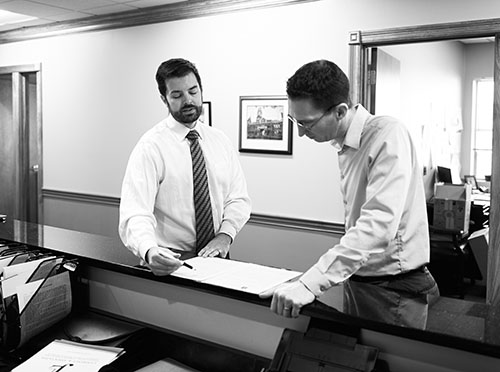The Intersection of Personal Injury and Bankruptcy: What Happens When Your Personal Injury Claim Intersects with the Defendant’s Bankruptcy
Posted on Tuesday, March 27th, 2018 at 9:53 am
The following post is part of our Law Student Blog Writing Project, and is authored by Thomas Rovito, who is pursuing his Juris Doctorate at the Ohio State University.
Note from editor: This article discusses federal law and cites to sources outside the Cincinnati and Northern Kentucky area. If you live in Cincinnati or Northern Kentucky, you can review Kentucky specific case law at our article for the Advocate, which is re-printed here.
Consider the following hypothetical. You are driving your car on the way to work, and you get t-boned at an intersection. You, as plaintiff, commence personal injury litigation against the other driver, as defendant, but in the midst of this litigation, the defendant driver files for bankruptcy as a debtor. Do you lose your lawsuit, or what do you have to do to keep the lawsuit alive?
While this situation is not the norm, bankruptcy attorneys do come across a few cases that fit the above fact pattern. And some of those attorneys have drafted white papers to facilitate knowledge on the process of preserving the plaintiff’s claim, such as the standout article by Jeffrey Traurig, “Defendant in Personal Injury Action Files for Bankruptcy – Now What?,” as well as “Scheduling and Protecting Personal Injury and Other Causes of Action in Bankruptcy Cases,” and “How Bankruptcy Affects Personal Injury Lawsuits.”
First, upon the debtor-defendant’s petition for bankruptcy, the bankruptcy court will grant an automatic stay to the personal injury litigation pursuant to 11 U.S.C. § 362(a). This stay will pause external litigation during the course of the bankruptcy proceeding. Once plaintiff’s counsel is on notice (either through being filed and served through the court of the personal injury claim or bankruptcy court, hearing from the client, or learning through a publication), the plaintiff’s counsel must obey the stay, as actions taken in violation of the stay “are generally void,” and are possibly punishable with sanctions from 11 U.S.C. § 362(k). The plaintiff’s attorney should monitor any bankruptcy filings or notices to note any changes to the automatic stay or any determinations that would result in claim or issue preclusion.
It also matters what kind of bankruptcy the debtor is seeking from the bankruptcy court. For instance, if the debtor is petitioning for a Chapter 7 liquidation, then plaintiff’s counsel should timely file a “proof of claim” against the debtor’s estate. According to Traurig, a timely filing means “a proof of claim must be filed before the proof of claim deadline regardless of whether a claim is scheduled as undisputed.” A claim, under 11 U.S.C. § 101(5), is a “right to payment, whether or not such right is reduced to judgment, liquidated, unliquidated, fixed, contingent, matured, unmatured, disputed, undisputed, legal, equitable, secured, or unsecured.” The “proof of claim” must be presented on the official proof of claim form pursuant to Federal Rules of Bankruptcy Procedure 3001 to the bankruptcy court, which is a necessary precondition to receive disbursements from the debtor’s estate. To improve the relative chances of success, the plaintiff should attach legal documentation, such as the summons and complaint (ideally with medical records and evidence of damages) against the defendant. Plaintiff’s counsel should be vigilant for any bankruptcy filings or public notices regarding the proof of claim deadline, and seek to preserve and present any credible evidence of the plaintiff’s injuries.
Another possible move plaintiff’s counsel could make to ensure timely compensation for his client is to petition the court to modify the automatic stay through 11 U.S.C. § 362(d). As the bankruptcy automatic stay may last years, it may delay compensation for the plaintiff; however, 11 U.S.C. § 362(d)(1) allows “[o]n request of a party in interest and after notice and a hearing, the court shall grant relief from the stay provided under subsection (a) of this section, such as by terminating, annulling, modifying, or conditioning such stay—(1) for cause. . . .” It is important to note that “cause” is not defined in the relevant section, and that the various circuit courts have applied different factor based tests to evaluate whether there is “cause.” As noted by Traurig, courts may consider whether the debtor was insured and how much the debtor would pay during the cause evaluation:
Because prejudice against a debtor is one of the primary factors in any balancing test, one of the factual issues that weighs heavily in determining whether the automatic stay should be lifted for a personal injury action to proceed is whether insurance is available to satisfy the claim and whether the debtor would be required to pay defense costs or deductibles. If a debtor has sufficient third party commercial coverage with no deductible (or a deductible that has already been met) and if the insurance carrier is responsible for all defense costs with no premium adjustment, it is likely that a bankruptcy court would authorize the lifting of the automatic stay to permit the claimant to proceed against insurance.
On the other hand, if the debtor is responsible for defense costs and deductibles, or if insurance will not satisfy the claim in full, the court will need to balance the factors to determine whether the stay should be lifted, including whether there is a likelihood that pre-petition unsecured creditors will receive distributions in the bankruptcy case and the ultimate need for the claim to be liquidated, as well as whether the claimant will agree to waive claims against the debtor’s estate if insurance is not adequate.
Thus, if the preconditions of 11 U.S.C. § 362(d) are met, and the defendant has insurance and would be subject to minimal cost, then there is an enhanced possibility of the bankruptcy automatic stay being modified.
An additional complication concerns the statute of limitations for the plaintiff’s claim and the imposition of the automatic stay. According to Traurig, while the statute of limitations “may” be extended, it “is not tolled.” Thus, plaintiff’s counsel should keep an eye on whether the statute of limitations is running down, and whether plaintiff’s counsel could file within 30 days’ notice of the termination of the automatic stay, pursuant to 11 U.S.C. § 108(c).
Thus, as Traurig concludes, the key to keeping your claim alive at the intersection of personal injury and bankruptcy is to ensure:
[T]hat proper steps be taken to ensure that a claimant’s rights are protected and that the attorney is properly representing the client, including ensuring that a proof of claim is timely filed and that the statute of limitations does not expire after the termination of the stay. Attorneys should also consider whether they should actively seek to modify the automatic stay to proceed against insurance while the bankruptcy is pending and should review notices and other pleadings filed in the bankruptcy case to ensure that orders are not entered that impair the ability to proceed against available insurance and should consider monitoring the docket in the bankruptcy case.
If you’ve been hurt in an accident or need to file bankruptcy, don’t go it alone! Lawrence & Associates Accident and Injury Lawyers, LLC offers free, confidential consultations and has helped thousands of people in Cincinnati and Northern Kentucky. We’re Working Hard for the Working Class, and we want to help you!









